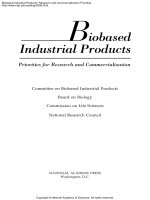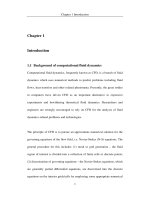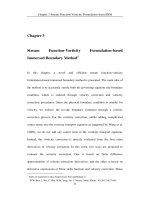Scanning thermal microscopy methodology for accurate and reliable thermal measurement
Bạn đang xem bản rút gọn của tài liệu. Xem và tải ngay bản đầy đủ của tài liệu tại đây (5.73 MB, 199 trang )
SCANNING THERMAL MICROSCOPY
METHODOLOGY FOR ACCURATE AND RELIABLE
THERMAL MEASUREMENT
HO HENG WAH
A THESIS SUBMITTED
FOR THE DEGREE OF
DOCTOR OF PHILOSOPHY
DEPARTMENT OF ELECTRICAL AND COMPUTER
ENGINEERING
NATIONAL UNIVERSITY OF SINGAPORE
2012
i
ACKNOWLEDGEMENTS
I would like to convey my sincere appreciation to my supervisor Professor Jacob Phang
for his patience, guidance and encouragement in the course of performing this research
project, as well as his valuable insights into life as a research engineer.
My sincere thanks also go to Professor L.J. Balk of the University of Wuppertal,
Germany, for many of his constructive advice and assistance he had rendered during the
difficult moments encountered in the project.
I like to express my deep appreciation to Mrs Ho Chiow Mooi for always being available
to provide ready assistance whenever I need any equipment or room in order to carry out
any experimental work.
I would also like to thank Dr Lap Chan and Dr Ng Chee Mang from
GLOBALFOUNDRIES, Singapore for allowing me to be in the company postgraduate
special project team. They have provided me with invaluable training related to the
working of a foundry and wafer fabrication process as well as the company for providing
additional top-up to my research scholarship. This program has also given me great
opportunities to interact and learn from other postgraduate students in the team who are
researching on various semiconductor related fields.
Last but not least, I would like to thank all research students and friends at CICFAR for
providing the necessary help in one way or another.
ii
SUMMARY
The rapid scaling of semiconductor devices coupled with demand for increasing
interconnect density, current density, power consumption and introduction of new
materials such as low-k dielectric with poor thermal conductivity exacerbates device
reliability with increasing temperature dependence. The introduction of multi-core
processor with an ever increasing array of sensors such as accelerometer, gyroscope and
proximity sensor into portable devices has also placed greater focus on the thermal
budget.
There is therefore a need for thermal characterization and measurement of these devices
and materials. Scanning Thermal Microscopy is one thermal measurement technique with
great spatial and thermal resolution to be compatible with advance technology node and
beyond. However, since it is a probe based technique and due to its sensitivity,
topography artifacts are easily coupled into the thermal measurement due to changing
thermal contact area between the scanning probe and the device-under-test (DUT). It is
also affected by thermal drift and overall heating of the DUT during the whole
measurement process.
The proposed setup introduces another lock-in amplifier into the measurement system.
This has allowed for the compensation of varying thermal contact area at each
measurement point, eliminating the effect of topography coupling into the thermal
measurement. Furthermore, any effect from thermal drift and overall heating of the DUT
will be limited to the dwell time of the thermal probe at each data collection point. The
setup has been demonstrated successfully on an electromigration structure and sensitive
down to a current supply of 7 mA (0.264 MA/cm
2
). This has enabled the sensitive
Scanning Thermal Microscopy technique to be more accurate and reliable for thermal
analysis. Calibration of the setup shows a sensitivity of about 0.584 V/K at the output of
the first lock-in amplifier.
iii
TABLE OF CONTENTS
Page
ACKNOWLEDGEMENTS
Summary ii
List of Abbreviations vii
List of Symbols ix
List of Tables xi
List of Figures xii
Chapter 1: Introduction 1
1.1 Scaling Trend 1
1.2 Thermal Management 2
1.2.1 Thermal Transport 3
1.2.2 Thermal Transport of Probe In Contact with Sample 5
1.2.3 Thermal Challenges 8
1.3 Project Motivation 11
Chapter 2: Literature Review 14
2.1 Review of Thermal Measurement Techniques 14
2.2 AFM based SThM Measurement 20
2.2.1 Thermovoltage 22
2.2.2 Thermal Expansion 27
2.2.3 Electrical Resistance 29
iv
2.2.4 Resistive Thermal Probes 36
2.3 Double Modulation for Topography Noise Decoupling 42
Chapter 3: Wheatstone Bridge 45
3.1 Various Configurations of Wheatstone Bridge 46
3.1.1 Current vs Voltage Sources 48
3.1.2 D.C. vs A.C. Excitation 49
3.2 Wheatstone Bridge for Thermal Detection 49
3.2.1 A.C. Bridge Theory and Balancing 51
3.2.2 Linearity 52
3.2.3 Sensitivity 54
3.2.4 Stability 55
Chapter 4: SLIA SThM Setup and Configuration 59
4.1 SThM Experimental Setup 59
4.1.1 Scanning Probe Microscope (SPM) 60
4.1.2 Optical Topography Detection System 60
4.1.3 Resistive Thermal Probe 61
4.1.4 Lock-In Amplifier (LIA) 63
4.2 PID Feedback System 64
4.3 SLIA Temperature Measurement (Quantitative) 67
4.3.1 SLIA Temperature Calibration 69
4.3.2 Results for Single Lock-In Temperature Calibration 72
v
4.4 SLIA Thermal Conductivity Measurement (Qualitative) 74
4.5 Proper Sample Mounting and Leveling for Accurate Thermal
Measurement
78
Chapter 5: SLIA SThM Applications 82
5.1 Electromigration Test Structure (Temperature) 82
5.2 Hard Disk Write Head Heater Coil (Temperature) 83
5.3 Electromigration Test Structure Characterizations (Thermal
Conductivity) [120]
90
5.3.1 Extrusion 91
5.3.2 Subsurface Void 95
Chapter 6: SLIA SThM Limitation and Optimization 97
6.1 Topography Artifacts 97
6.2 Temperature Drift During Thermal Measurement 100
6.3 Thermal Signal Recovery Where Temperature Drift Exists 106
6.3.1 Temperature Leveling 110
6.3.2 Temperature Normalization 114
Chapter 7: Double Lock-In Technique for SThM 116
7.1 Double Lock-In Experimental Setup 116
7.2 Double Lock-In Theoretical Treatment 120
7.3 Thermal Interpretation of Double Lock-In Scheme 128
7.4 Double Lock-In Characterization 129
vi
7.4.1 Thermal Time Constant Extraction of DUT 131
7.4.2 Dwell Time of Thermal Probe 132
7.4.3 Effect of LIA Time Constant (TC) Parameter 135
7.4.4 Repeatability of Double Lock-In Result 140
7.4.5 Effect of DUT Biasing Frequency on Double Lock-In Thermal Signal 143
7.5 Summary 147
Chapter 8: Double Lock-In Technique Application 148
8.1 Effect of Varying DUT Heating Current 148
8.2 Experimental Verification of Double Lock-In Model and
Temperature Calibration
154
8.3 Summary 159
Chapter 9: Conclusion 160
Chapter 10: Recommendation for Future Work 162
References 164
List of Publications 179
vii
List of Abbreviations
ITRS International Technology Roadmap for Semiconductor
DRAM Dynamic Random Access Memory
NA Numerical Aperture
MPU Microprocessor
SThM Scanning Thermal Microscopy
SJEM Scanning Joule Expansion Microscopy
PID Proportional-integral-derivative
AFM Atomic Force Microscope
LIA Lock-In Amplifier
SPM Scanning Probe Microscope
SFM Scanning Force Microscope
STM Scanning Tunneling Microscope
EOM Electro-optic Modulator
DUT Device-Under-Test
ECU Electronic Control Unit
CH1 Channel 1
Ag Silver
Pt Platinum
a.c. Alternating current
1D 1-directional
SLIA Single Lock-In Amplifier
EM Electromigration
viii
TC Time Constant
RMS Root Mean Square
VCO Voltage-Controlled Oscillator
PSD Phase Sensitive Detector
DC Direct Current
LPF Low Pass Filter
SNR Signal –to-Noise Ratio
DLIA Double Lock-in Amplifier
SNPEM Scanning Near-Field Photon Emission Microscopy
PET Poly (ethylene terephthalate)
EC Electrocaloric
MLC Multilayer capacitor
NPM Nullpoint method
ix
List of Symbols
j
Irradiance with dimension of energy flux
ε
Emissivity
σ Stefan-Boltzmann constant
T
Absolute temperature
λ Wavelength
l
Mean free path
C
Capacitance
V
Voltage supply
f
Frequency
R
probe
(T) Resistance of probe at temperature T
0
R
Resistance of tip at ambient temperature T
0
probe
Coefficient of resistivity of the probe
ω Angular frequency
p
Angular frequency of DUT biasing
n
T
Thermal measurement noise
s
T
Sample/substrate Temperature
a
T
Ambient Temperature
c
R
Cantilever thermal resistance
t
R
Tip resistance
ts
R
Probe-sample resistance
x
p
C
Specific heat capacity
Thermal conductivity
Δv
0
Change in output voltage
ΔR
4
(T)
Resistance change of the resistive probe
K
R
Wheatstone bridge sensitivity
R
2
Linear regression goodness of fit
P(t)
Power of periodic pulsed heating
P
0
Peak power of unipolar rectangular current bias
C
th
Thermal capacitance
R
th
Thermal resistance
t
p
DUT biasing period
ΔT
m
DC joule heating of sample
th
Sample thermal time constant
xi
List of Tables
Table 1.1 Typical length and time scales for energy carriers in solids at
room temperature [2]
4
Table 4.1 Material property of thermal probe [103] 62
Table 7.1 RMS and SNR of the thermal signal measured 142
xii
List of Figures
Fig. 1.1 DRAM M1 ½ pitch scaling trend 1
Fig. 1.2 Schematic diagram of a SThM probe in contact with a
Joule heated metal line. Also shown are various tip-
sample heat transfer mechanisms. [14]
5
Fig. 1.3 Cantilever deflection and temperature response of the
probe as a function of sample vertical position when the
350 nm wide line was raised towards and then retracted
from the tip
6
Fig. 1.4 On-Chip Frequency Trend 10
Fig. 2.1 (a) Topography and (b) PL intensity ratios converted to
temperature for i = 0 mA and (c) i = 13 mA. The scale
bar is 10 μm. (d) The curves are cross sections extracted
from the images in (b) and (c) in directions A and B.
16
Fig. 2.2 Thermograph image of an interconnect after
accumulated for 10s [40] (a) before electromigration (b)
after electromigration (c) Temperature profile of (b)
18
Fig. 2.3 Flow Chart of Various Scanning Thermal Microscopy
System
22
Fig. 2.4 (a) SEM of multi-function micro thermal cantilever, and
(b) block diagram of thermal feedback system
24
Fig. 2.5 Schematic diagram of SThM probe in contact with
sample and various heat transfer paths around the probe.
24
Fig. 2.6 Schematic on principle of quantitative thermal profiling
using double scan technique [55]
25
Fig. 2.7 (a) A schematic diagram of the experimental setup for
NP SThM. (b) SEM images of the SThM probe used in
the experiment. The diameter of the thermocouple
junction integrated at the apex of the tip is about 100 nm,
and the tip radius is about 50 nm. [57]
26
xiii
Fig. 2.8 (a) Schematic setup for scanning joule expansion
microscopy
(b) Topography and thermal expansion micrographs of
two 160 nm thick gold lines at current density of 5.9
MA/cm
2
28
Fig. 2.9 MLC and SThM schematic for EC measurement 30
Fig. 2.10 SThM measurements of EC effects in an MLC. (a)
Temperature change ∆T versus time, on applying and
removing V=200V as indicated. (b) EC heating (open
circles) and cooling (closed circles) as a function of tip-
sample separation.
31
Fig. 2.11 Modes of Operation for Resistive Based
Scanning Thermal Microscopy (SThM)
32
Fig. 2.12 Block Diagram for Passive/Active SThM Measurements
32
Fig. 2.13 Representation of the electronic circuit of the SThM with
feedback loop for constant temperature operation [72]
34
Fig. 2.14 Schematic of scanning thermal microscopy equipped
with a servo-controlled interface circuit using electrical
temperature dithering and an ultracompliant
micromachined thermal sensor
35
Fig. 2.15 Thermal Transport of a Simple Thermal Resistance
Network Model [77]
37
Fig. 2.16 (a) Wollaston probe [46] and (b) nanofabricated thermal
probe [78]
38
Fig. 2.17 (a) SEM images of batch fabricated dual cantilever
probes with tip-to-tip spacing of 300 nm and (b) 2 µm, (c)
schematic of experimental setup for thermal scan with a
dual cantilever resistive probe
40
Fig. 2.18 Schematic of scanning thermal microscope using a novel
four-terminal thermoresistive nanoprobe with a modified
Wheatstone bridge setup
41
Fig. 2.19 (a)SThM micrograph showing the “double-line” – like
structure and (b) the corresponding profile across the
nanowire
42
xiv
Fig. 3.1 Schematic of Maxwell bridge for inductance
measurements
46
Fig. 3.2 Schematic of a Kelvin Double bridge 47
Fig. 3.3 Schematic of SThM Setup (Wheatstone Bridge, LIA,
ECU)
50
Fig. 3.4 Schematic of the Wheatstone Bridge with Integrated
Operational Amplifier
51
Fig. 3.5 A Plot of Sensitivity against Arm Ratio 54
Fig. 3.6 Metal housing for the variable inductor 56
Fig. 3.7 Behaviour of Wheatstone bridge output variation to
reach the balanced condition
58
Fig. 4.1 Schematic Setup for Passive/Active SThM Measurements
59
Fig. 4.2 Schematic of Resistive Wollaston Wire Probe 61
Fig. 4.3 Closed-Loop PID Feedback in AFM [108] 64
Fig. 4.4 Topography Micrographs of 1D Line Scan 65
Fig. 4.5 Proportional and Integral Optimization for a Line
Feature
66
Fig. 4.6 Schematic setup for SLIA temperature measurement 67
Fig. 4.7 (a): Temperature calibration with a thick copper track
and thermocouple (b): Temperature calibration with a
black body
69
Fig. 4.8 Temperature calibration with platinum resistance
thermometer (PT100). Schematic (left) and actual
(right).
71
Fig. 4.9 Schematic of SThM Calibration Scheme 72
Fig. 4.10 Temperature calibration plot for single lock-in setup 73
Fig. 4.11 Schematic setup for SLIA thermal conductivity
measurement
74
xv
Fig. 4.12 Graphical Explanation of 3ω Method [112] 75
Fig. 4.13 Increased Contact Area due to Unleveled Sample 79
Fig. 4.14 Physical Leveling of Sample 79
Fig. 4.15 Artifact Due to Leveling 80
Fig. 4.16 Effect of Leveling 81
Fig. 5.1 Thermal micrograph overlaid with optical micrograph of
a biased interconnect with presence of a void. [115]
82
Fig. 5.2 (a): Optical micrograph of an unshielded type hard disk
TFC PMR head
(b): Schematic of AFM/SThM measurements of TFC
perpendicular head with cross-sectional view of head
structure illustrated. (MP: main pole; RP1: return pole 1
(leading or bottom side); RP2: return pole 2 (trailing or
top side); Htr: heater; IWr: writing current/voltage
source; IHtr : heating current/voltage source; R:
resistor).
85
Fig. 5.3 AFM images of TFC PMR head during writing current
on and off. (Image size: 1μm by 1μm; height contrast: 50
nm.)
86
Fig. 5.4 (a): Topography micrograph
(b): Temperature micrograph with heating supply of
~12.5 mW
(c): Topography micrograph zoom in at heater location
(d): Temperature micrograph zoom in at heater location
87
Fig. 5.5 SThM image and temperature profiles versus time
during heater on and off (heater power ∼33 mW). (a)
Thermal micrograph of TFC perpendicular head along
similar line as AA’ in Fig. 5.4 (b) over time (horizontal
axis of distance from left to right is 100μm; vertical axis
of time from top to bottom is 20 min); (b) thermal line
profiles at the centre (CC’) and off-centre (BB’) of the
heat source as a function of time.
89
Fig. 5.6 Micrographs of an EM sample 91
Fig. 5.7 Thermal Conductivity Micrograph 92
xvi
Fig. 5.8 Heating of DUT in dynamic mode 93
Fig. 5.9 Heat Flow Proposal 94
Fig. 5.10 Micrographs of an EM sample with subsurface voids 95
Fig. 5.11 Line Profile of Topography and Thermal Conductivity 96
Fig. 6.1 Schematic showing increased area of contact
(topographic artifact) due to step change in topography
98
Fig. 6.2 (a): Topography micrograph (left) and corresponding
line profile (right) of calibration grid
(b): Temperature micrograph (left) and corresponding
line profile (right) of calibration grid
99
Fig. 6.3 Optical micrograph of an electromigration (EM)
sampled used for thermal measurement
101
Fig. 6.4 (a): Thermal micrograph obtained 30 min from start of
experiment.
(b): Thermal micrograph obtained 60 min from start of
experiment.
(c): Thermal micrograph obtained 90 min from start of
experiment.
101
Fig. 6.5 Temperature line profiles Along AA’, BB’ and CC’ of
Fig. 6.4 at various settling time after equipment setup
102
Fig. 6.6 Plot of temperature delta at increasing SLIA SThM
settling time
103
Fig. 6.7 Average temperature variation measured immediately
after instruments were turned on and actuated up to
stabilization [121]
104
Fig. 6.8 (a): 1D topography micrograph of measurement time vs
distance along AA’ in Fig. 6.3
(b): Line profiles at various measurement time
(c): Zoom in of Fig. 6.8 (b) along step profile between 20
and 24 µm
105
Fig. 6.9 BJT with emission spot detected with a cooled CCD
camera (PEM)
107
xvii
Fig. 6.10 (a): SNPEM Micrograph
(b): Topography
(c): Overlay of SNPEM with Topography
107
Fig. 6.11 Topography of emission spot as acquired with thermal
probe
108
Fig. 6.12 (a): Topography profiles of PN junction at various
leakage current
(b): Temperature profiles of PN junction at various
leakage current
109
Fig. 6.13 (a): 1 Point leveling algorithm
(b): 2 Points leveling algorithm
111
Fig. 6.14 (a): 1 point leveling for temperature profiles at various
leakage current
(b): 2 point leveling for temperature profiles at various
leakage current
113
Fig. 6.15 Normalized temperature profiles at various leakage
current
115
Fig. 7.1 Double Lock-In Experimental Setup 116
Fig. 7.2 Illustration of thermal signal through two lock-in
amplifiers: (a) Current Bias of DUT under unipolar
biasing, (b) temperature of DUT due to unipolar biasing,
(c) voltage output of LIA_A that is passed into LIA_B
and (d) voltage output of LIA_B
118
Fig. 7.3 Illustration of LIA_A’s Output vs Time at Various
DUT’s Thermal Time Constant for DUT Biasing
Frequency of 40 Hz
119
Fig. 7.4 Lock-In Amplifier Schematic [125] 124
Fig. 7.5 (a) LIA_A output with period tp and (b) LIA_A output
captured from an oscilloscope
126
xviii
Fig. 7.6 (a) Schematic of sample cross section (not FIB), (b)
optical image of sample surface where biased
interconnect and scanned location is indicated, (c) SEM
top view of sample and (d) topography micrograph of
scanned location
130
Fig. 7.7 Plot of Voltage Output vs Time at Various DUT’s
Thermal Time Constant
132
Fig. 7.8 1D thermal and topography line profile across a biased
interconnect along BB’ in Fig. 7.6 (b)
133
Fig. 7.9 (a) Thermal Signal at The Output of LIA_B at Various
TC and (b) its Equivalent Spectrum
136
Fig. 7.10 Plot of SNR vs ratio of (tp/TC) 138
Fig. 7.11 Plot of DLIA Output at Various Sets of TC Ratio 139
Fig. 7.12 Thermal Line Profiles Across a 125 Hz Biased
Interconnect for Two Separate Measurements on
different days at (a) 1 mA, (b) 10 mA and (c) 20 mA
141
Fig. 7.13 Thermal Line Profile Plots at Various DUT Biasing
Frequency
143
Fig. 7.14 Plot of LIA_B Output vs DUT Biasing Frequencies and
Selected Thermal Line Profile at various DUT Biasing
Frequencies
145
Fig. 7.15 Thermal Line Profile Plots vs Ratio of DUT Biasing
Period Over Thermal Time Constant
146
Fig. 8.1 1-Dimensional Micrographs for (a) Topography, (b)
Single Lock-In Thermal and (c) Double Lock-In
Micrograph of DUT at Various Heating Current
149
Fig. 8.2 Thermal Line Profiles Obtained from (a) Single and (b)
Double Lock-In Measurement under Various Heating
Current
150
Fig. 8.3
Plot of Lg (
BLIAout
V
__
) vs Lg (I) for DUT current bias
from 1 mA up to 20 mA at 1 mA interval
153
xix
Fig. 8.4 (a) SLIA Difference Thermal Signal and (b) DLIA
Thermal Signal At Various Current Supply
155
Fig. 8.5 Simulation of Temperature Rise of Interconnect With a
Supply of 50 mA Current
157
Fig. 8.6 Temperature Calibration Plot for DLIA Setup 158
Fig. 8.7 Schematic of the various stages in the thermal signal
pathway
159
Fig. 10.1 Schematic of proposed DLIA setup for quantitative
thermal conductivity measurement
163
Chapter 1
1
Chapter 1: Introduction
1.1 Scaling Trend
The semiconductor industry has been and is still experiencing a rapid pace of
downscaling which has kept pace with Moore’s Law prediction of doubling the transistor
density on a manufactured die every 24 months. According to the 2012 International
Technology Roadmap for Semiconductors (ITRS) [1] where industry-wide consensus on
semiconductor trends is presented, the DRAM half-pitch is predicted to scale by
approximately 0.7 times every 3 years as shown in Fig. 1.1.
0
5
10
15
20
25
30
35
40
2010 2012 2014 2016 2018 2020 2022 2024 2026
DRAM M1 1/2 Pitch (nm)
Year of Production
2012 ITRS: Scaling Trend
DRAM M1 1/2 Pitch (nm)
Figure 1.1: DRAM M1 ½ Pitch Scaling Trend
This downscaling has facilitated the reduction of cost per function and allowed for the
continued market growth for integrated circuits. The MPU density is also expected to
Chapter 1
2
double every 2 years till 2013 and then expected to continue doubling on a 3 year cycle.
Meanwhile, the DRAM bits/chip continues doubling on a 3 year cycle as well. However,
this traditional/geometrical scaling is getting very challenging. This can be easily
observed in foundries where one of the bottlenecks and cost is the lithography tools. A
current 193 nm immersion lithography machine can cost up to US$40 million per unit.
Furthermore, it is limited by numerical aperture (NA) to resolve 32 nm half pitch and
requires creative lithography solutions such as double patterning or exposure. This allows
the pitches to be split into larger ones, but at the expense of almost twice the lithography
cost.
Other than the traditional scaling or geometrical scaling as called for in Moore’s Law,
equivalent scaling such as introduction of stress into the channel to improve transistor
performance, innovative processing such as using tri-gate or gate-all-around transistors
are taking an even more significant role in the future trends of microelectronics. More
innovative methods being explored include the use of nanowires and nanotubes for
electron transport, using III-V compounds as replacement for silicon transistors or the use
of photons in optoelectronics to transmit data.
1.2 Thermal Management
With an increase in the complexity of microelectronic circuits, the power density also
increases with more heat generated per device. Heat generation and conduction can
influence the reliability of semiconductor devices and interconnects. Thermal
management is therefore becoming an increasingly important factor in the performance
Chapter 1
3
of advanced microelectronic devices. Hence, understanding and controlling the heat
transfer by being able to characterize the thermal behaviour is of significant interest in
practical applications concerned with heat management.
1.2.1 Thermal Transport
Heat is the transfer of energy from one body to another as a result of thermal contact.
Thermal contact facilitates the transfer of energy namely by three modes, conduction,
convection and radiation. In electronic devices, electron flow occurs in metals and
semiconductors. For heat, it flows through all materials.
Convection is the main heat transfer mechanism in liquids and gases. It consists of fluid
flow between hot and cold regions and heat transfer by conduction. As for radiation, it
can occur without any medium in the form of electromagnetic waves. Stefan-Boltzmann
law states that the total energy radiated per unit surface area per unit time is proportional
to the fourth power of temperature as shown in Eqn. 1.1.
4
Tj
(1.1)
where j is irradiance with dimension of energy flux (energy per unit area per unit time), ε
is emissivity (ε = 1 in the case of a perfect black body), σ is the Stefan-Boltzmann
constant and T is the absolute temperature.
In solids at the microscopic level, thermal transport is predominately through conduction
by two energy carriers. Electrons flow in metals, and phonons (lattice vibration) in
insulators and semiconductors [2]. Table 1.1 lists the typical range of values for the
Chapter 1
4
length and time scales of electrons and phonons. This also defines the physical resolution
limits for thermal measurements.
Table1.1: Typical Length and Time Scales for Energy Carriers In Solids at Room
Temperature [2]
Electrons In Metal Phonons in Insulators and
Semiconductors
Wavelength, λ [nm] 0.1 – 1 1 – 5
Mean Free Path, l [nm]
10 10 – 100
Relaxation Time, τ [s] (10 – 100) x 10
-15
(1 – 10) x 10
-12
Propagation speed, υ [m/s] 10
6
(3- 10) x 10
-3
Although thermal conductivity is an intrinsic property, studies have shown that the
thermal conductivity of thin films is also affected by film thickness and microstructure. A
reduction in thermal conductivity of 10% for films in the 1 μm range [3] and up to 50%
reduction for films on the order of 100 nm [4] compared to bulk silicon have been
observed. Doping also affects silicon films’ thermal conductivity [5] while grain
boundary scattering is a factor for thermal conductivity reduction in polysilicon films
[6][7][8]. When the hotspot is less than the phonon mean free path, localized heating
occurs, resulting in significant increase in thermal resistance for conduction. Therefore,
thermal characterization is essential as its behaviour can be drastically different from its
bulk performance.
Cahill [9] has provided a comprehensive review of the theory, experiments and
simulation models of the current understanding of thermal transport at nanoscale level. In
the area of computational approach to heat transfer, numerical solutions of Fourier’s law
[10] to calculation based on the Boltzmann transport equation [11][12] to atomic level
simulations have been discussed and reviewed.
Chapter 1
5
1.2.2 Thermal Transport of Probe In Contact with Sample
In the context of a thermal probe in contact with a sample, the relative contribution of the
various heat transfer mechanisms had been studied extensively by Shi et al. [13][14]
using a thermocouple based probe as shown in the following schematic diagram.
Figure 1.2: Schematic diagram of a SThM probe in contact with a Joule heated metal
line. Also shown are various tip-sample heat transfer mechanisms. [14]
The various heat transfer mechanisms include
solid-solid conduction at the probe contact
conduction through the air gap between the probe and the sample
radiation
heat conduction through the liquid meniscus formed at the probe-sample junction.
The liquid meniscus is formed from water molecules and/or contaminations adsorbed on
the sample and probe surfaces.









